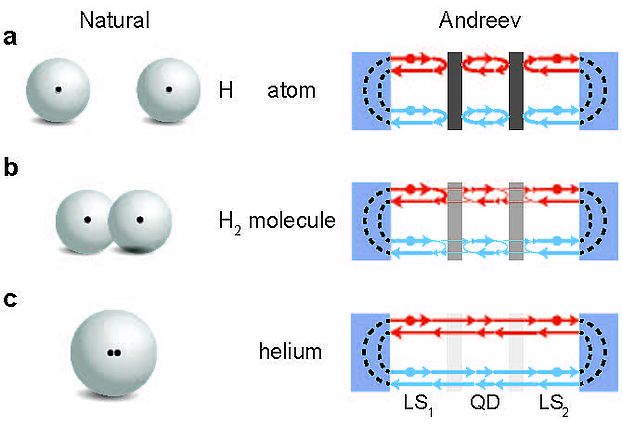| Jul 28, 2023 |
'Andreev chemistry' on a nanowire
(Nanowerk News) Researchers at the University of Basel and Lund University have generated superconducting pair states of electrons on several segments of a nanowire, separated by grown barriers. Depending on the height of the barriers, these pair states can be coupled and fused. The results were recently published in the scientific journal Communications Physics ("Intermediate states in Andreev bound state fusion") and provide important insights for the development of new quantum states.
|
|
In a superconductor, electrons form a kind of pair that results in new material properties such as dissipationless currents. If a semiconducting material is brought into contact with a superconductor, the electrons of a semiconductor can also enter into similar pair states known as Andreev bound states (ABSs).
|
|
Such states that form on individual, long, thin crystals – so-called nanowires – have become the focus of increasing research for several years, as they might be particularly good information carriers.
|
 |
| a) Andreev atoms: At high barriers, single, independent Andreev bound states are formed – analogous to two single hydrogen atoms. b) Andreev molecules: If the barriers between the segments are reduced, coupled Andreev bound states are formed – analogous to a hydrogen molecule. c) Andreev helium: At very low barriers, the individual ABSs merge so that the pair states extend over the entire nanowire – analogous to a helium atom – conducting electric current without dissipation. (Image: University of Basel)
|
Analogies to chemistry
|
|
Researchers in the team of Professor Christian Schönenberger and Dr. Andreas Baumgartner from the Department of Physics and Swiss Nanoscience Institute at the University of Basel and colleagues from Lund University have now succeeded in generating such pair states on three segments of a nanowire, which are separated by barriers grown in the crystal. The scientists are able to manipulate the height of the barriers using an electrical voltage.
|
|
“We can identify the respective states by characteristics in the electrical current,” explains first author of the publication in Communications Physics, Dr. Christian Jünger. If the barriers are large, then individual, independent Andreev bound states form on the two segments near a superconductor. Analogous to the one-electron states in natural atoms in chemistry, these can be regarded as Andreev atoms. When the barriers between the segments are reduced, the ABSs become coupled, forming states often called Andreev molecules.
|
|
When the researchers lower the barriers almost completely, pair states are created that extend across the entire nanowire and conduct electrical current without dissipation – a phenomenon known as the Josephson effect. “This corresponds to a fusion of the original Andreev bound states into Andreev helium – similar to fused hydrogen atoms,” comments Dr. Andreas Baumgartner.
|
|
In future experiments, researchers will investigate this fusion process with a similar type of pair states, so-called Majorana bound states, and thus take an important step toward application for quantum computers.
|

